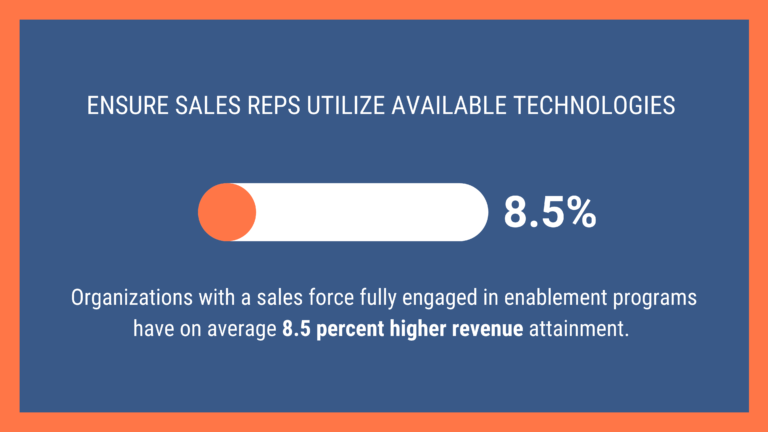
In the 2018 State of Sales report from Salesforce, 57 percent of sales reps missed their quota. Some sources say the number is now as high as 66 percent, which could very well be, with the economy still working through pandemic-related impacts.
Every successful sales leader has had the experience of a new sales representative who misses their mark. Or a top sales producer on their team who has hit a wall or is off course. In those cases, smart managers take action. They pinpoint a path for redirection or refocus.
In this blog, we engage high-performing enterprise sales leaders on approaches sales managers can take to coach sales reps through dips so they can hit, and even exceed, their quotas.
Establish Trust and a Relationship
The best sales leaders are target- and deadline-driven and hold their team to a high level of accountability, yet they create an environment where sales team members want to continually improve themselves. Sales management begins with empathy and a personal touch, and they add value to a team member’s sales process.
“Success is an emotional thing. You have to have a relationship with sales reps, and have their trust, for them to know they can learn something from you,” said Greg Wilkins, vice president of Commercial Marine Solutions at Veson Nautical (Boston, Massachusetts), which provides SaaS-based solutions for global commercial maritime fleet and freight management. Wilkins oversees complex enterprise sales to companies that manage the business side of some of the biggest ships in the world, managing shipments involving upwards of a billion dollars annually.
In the sales process, it’s of course up to the sales reps to succeed, but an essential element of success is a relationship with their sales manager, what Wilkins calls ownership with partnership.
“The only way you’re going to get an underperforming rep to a performing place is to be in the deal with them,” and that starts far before the situation is dire, he said. Either they believe you can help, or your input lands flatly and may even be rejected.
Especially when working with veteran sales reps, the relationship element is a core value to any sales process, said Vince Heidenreich, vice president of Enterprise Sales at Applied Systems (University Park, Illinois), a cloud-based insurance software provider for client management, data interchange, and other services. Heidenreich has nearly 30 years’ experience as a sales leader and rep and is an expert in enterprise direct, channel, and strategic sales. Throughout his career, he has often been hired in the position of fixer, to bring a team member or team back to performing health.
“At the highest level, I believe that happy people work harder and are more loyal than scared people,” Heidenreich said. He spends “a disproportionate amount of time” figuring ways that he can bring value to his relationship with his team members, assessing in what capacity he can be a unique asset. That includes evaluating a person’s inability to perform. Whether it’s being sensitive to individual personal family challenges or coaching on approaches to closing, Heidenreich uses customized evaluations, and every tool he has access to, to empower his sales team to succeed.
Establish Achievable, Measured Goals
“Part of managing anyone is understanding their motivations, and aligning to those motivations,” Wilkins said.

That starts with a lot of listening and articulating goals. For underperforming sales reps, use plain language and set clear, reasonable goals, Wilkins said. The level of detail in those goals relies on analytics and identifying traits individual to that person, to create a customized plan that makes sense to them.
Being empathetic and being clear go hand-in-hand, Heidenreich said. “You can’t sugar-coat where they are, and you can’t undervalue what is required to hit the improvement benchmark.” Heidenreich assesses the deficiencies in performance, and then customizes an approach that includes specific ways he brings value to a plan. Correctives can take many forms, from requiring a sales rep to work with sales enablement tools to working with the marketing team to update LinkedIn profiles.
Heidenreich described a veteran sales rep who could “light up a room.” He was personable and engaging with clients, but struggled with long-range strategy. After assessing the issue, they built and documented a plan, an overall visual framework for a long-term strategy, then broke it down into tactical steps, week by week, identifying measurable, achievable outcomes.
“You break things down into elements that they can execute successfully, and often in a short period of time,” Wilkins said. These digestible chunks attach to the outcomes that matter, keeping the sales process as simple as possible without jeopardizing its effectiveness.
Meet with Sales Reps, at a Minimum, on a Weekly Basis While Offering Regular Coaching Sessions
The first step in rectifying a performance problem is identifying there is one, Heidenreich said. Typically, for high-performing sales reps, issues usually manifest themselves in one of two ways: The quantity of activity suddenly decreases, the quality does, or, a third lesser option, both decrease.
Quantitative issues are more easily identified. The analytics dashboard tracks those issues and can provide visible indicators of unsuccessful engagement (“Ten onsite meetings, but no funnel is generated? There’s an issue,” Heidenreich said.). Evaluating and fixing qualitative issues is more time-intensive, but worth it. That requires sales leaders to engage in personalized, constructive feedback and encouragement in regular coaching sessions.
“Follow-up is minimally weekly, and in the real world, daily,” Heidenreich said. “I’m not the kind of guy who’s going to look at a funnel this week, and next week do coaching. I look at every opportunity to reinforce the behavioral skills to improve performance and achieve professional goals. My style is constant and subtle feedback.”
With that approach, he’s aware of issues even before the metrics waver. “Attitude is the first thing to go, then it’s productivity,” he said.
Heidenreich describes a long-time rep who would skip meetings and avoid interactions after his performance had slipped; he knew he was in line for termination. The attitude indicated professional distress. Heidenreich looked at the situation as an opportunity to offer a partnership for reengineering the sales reps’ process.
A handful of conversations later showed where the rep was failing to produce results. For one, “He was so focused on customer satisfaction issues that not enough time was spent on new sales opportunities,” Heidenreich said. “Instead of patching customers through to the support team, he dealt with the fix, diverting his attention away from prospecting.” And, therefore, from closing more deals and meeting quota.
New sales reps should be productive by at least six months, and fully up and running by a year, Wilkins said. With regular coaching sessions, the pipeline becomes a transparent and immediate indicator of when a sales rep is in jeopardy of not meeting goal, giving time before the end of the year to discuss changes. Do an assessment (insert yourself in a meeting, read emails, get on a call); identify skills that need improving; and focus on a sales training plan that will adequately address the issues, he said.
In addition, use regular micro-engagements in the context of the work being done to build trust, offer corrections, and add value, Wilkins said.
For instance, during informal check-ins, he noticed a rep’s calls were registering too low on the decision-making chain. The conversation turned to figuring how to best reach higher up the chain without risking the relationship with the existing contact. The quick connection to the reps’ work offered improvement in the short term that actually influenced the longer-term action plan.
Evaluate Sales Rep’s Messaging and Consistency in a Communicating Value
The best way to sell is to listen to customers and then drive the sales process around their needs, or the problem being solved, Wilkins said. “Nobody wants to hear that you will give them great value.” If you understand your value proposition well enough, you lead a prospect or a client to the conclusion on their own that your company solves their problem, thereby creating value.
With underperforming reps, Wilkins often finds they are unable to either articulate the problem the prospect or client has stated, or can’t state it for them.
“I say to the rep, ‘You’re going to ask the prospect for $500,000. Why are they going to pay? What matters in their business today that would make it important to spend that money?’” Problematic is an underperforming rep who replies with generalizations lifted from marketing materials, Wilkins said, rather than specifics from customer conversations, or who answers “I don’t know.”
The same red flags can arise around discovery, the ask, or the close, Wilkins said. The rep is unclear why they’re talking to one person versus another, or their uncomfortable making the ask. The next steps: Sales training or coaching reps to ask the right questions; finding out why they might be afraid; and helping them to get comfortable with each necessary step of the sales process.
Plan for Seasonality
Although not all industries are affected, the dog days of summer can be difficult for high-performing sales people to stay motivated and meet quota while juggling vacation schedules, Heidenreich said.
“Mentally you have the most engagement in Q1 during the kick-off months, it fades in Q2, and picks up in the beginning of Q4,” Heidenreich said. “I try to align most of their work when they are most engaged.”
For instance, frontloading to show 52-55 percent of quota in the first half of the year so there is less revenue to attain in the second half. Or coming up with an initiative to entice sales reps toward a high level of activity in August. Or boosting calls so when prospects come back from vacation, the sales reps’ voice is the first one they’ll hear.
Ensure Sales Reps Utilize Available Technologies
Organizations with a sales force fully engaged in enablement programs have on average 8.5 percent higher revenue attainment. Enablement tools are tailored to predictability. In today’s technology-assisted sales process, they offer a host of ways to access advanced metrics for coaching reps and increasing productivity.

“Incremental progress is what we are striving for,” Heidenreich said. “I want to be able to show to my superiors that my team is learning new skills.” Through enablement tools, underperforming sales reps “learn to fish, and better over time,” he said. “If you can raise the bar for mediocrity, there’s going to be a rise in the tide.”
Focus Attention on Multithreading
“The typical buying group for a complex B2B solution involves six to 10 decision makers, each armed with four or five pieces of information they’ve gathered independently.”
“Buying has gone from a single-person activity to purchasing by committee,” Heidenreich said, “and 85 percent of a person’s research is done before they even engage with a selling resource.”
In this environment, a sales reps’ initial contact may have no role in the close or in the day-to-day implementation of the service. “It requires that you enroll more people in the process,” Heidenreich said. With a multi-threading approach, reps can be coached to identify the appropriate decision-makers, build those relationships, identify other key players, and map their relationships.
Evaluate and Engage in the Dana Difference
A successful sales leader is not only a boss but a mentor who has the best interest of their team members in mind, Heidenreich said, even if that means finding a position outside the company when all efforts to address inadequate outcomes have been exhausted.
You want individuals to get to that conclusion on their own, Wilkins said. Often enough, because of the close working relationship between the sales rep and the sales leader, and the assessments and ongoing focus on improvements months before, they do.
“I’ve both coached people out and have had to terminate people,” Heidenreich said, but the former occurs more often than the latter. “I invest in the work to get them out.”
When it’s time to consider a new hire, DANA Associates will find you the most highly qualified prospective candidate. With our in-depth, personalized approach, we have the business-critical expertise to present you with highly vetted candidates for the job. Engaging in a hiring process is the perfect time to begin work with DANA Associates. Contact us today or give us a call to get started.

